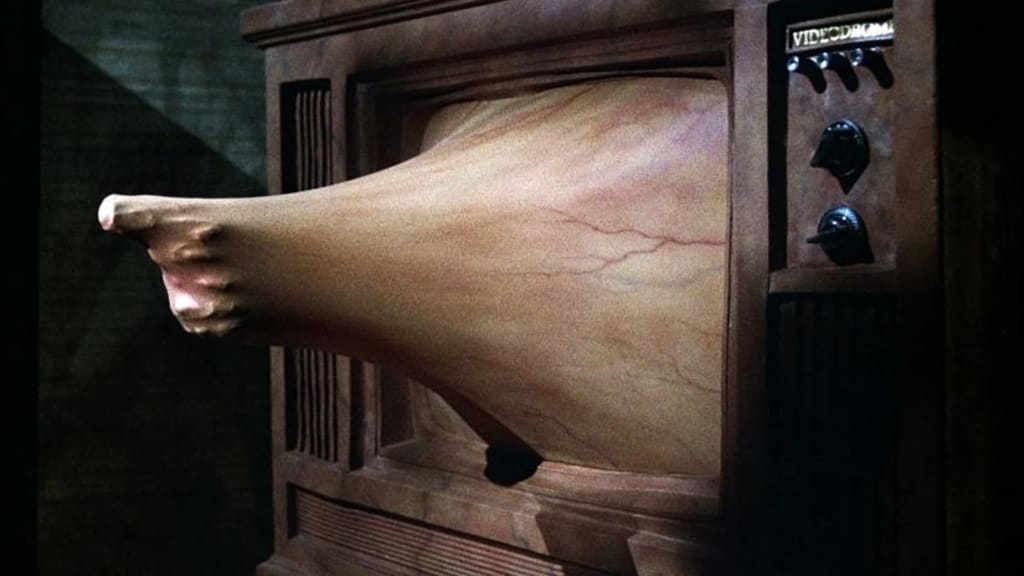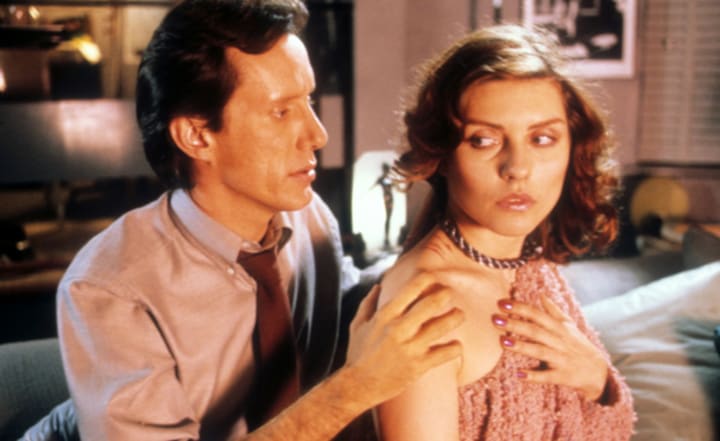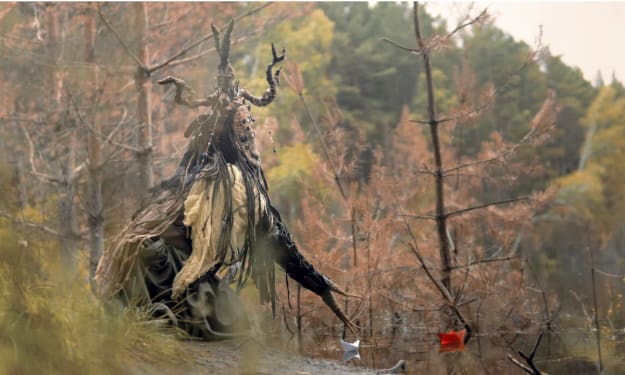
Film critic the late Roger Ebert once famously quipped that the colors of the movie Videodrome were mostly "those of dried blood." That was perhaps overstating things, but not by much. It is, at any rate, one of those lines that has stayed with me since I first read it in an annual anthology of Ebert's reviews as a child, maybe more than thirty years ago.
The future was then.
Videodrome is a sickening puke-bag of a horror movie, with the requisite 1980's chest-bursting and grue-filled special effects bladders. All the sorts of things that are, as far as I know, not really seen much in movies today. Mutant monsters and weird, wound-like openings in the pits of stomachs—and, did I mention the S and M?
Having taken the time to completely waste one hour and a half of my life, an hour badly needed to try and produce one, JUST ONE, work of art that outlasts my ever-meager and dwindling sentence upon this revolving prison in space, I was amazed at just how incredible the film still seemed nearly a decade or more since the last time I sat down to watch it in its entirety.
The sleazy 1980's visual feel of the film is as relentless as its cyberpunk themes of alienation and technological control, its cynicism and deep mistrust of hypocrisy and authority. Does it date well? Yes, and no. Not so much in the internet age; however, one can see the eerily similar parallel between our present cybernetic and virtual worlds of pleasure and hedonism, our escapist fantasies of revenge, power, and control, our willingness to be "lead by the nose" by the electronic media, with the metaphorical cautionary tale being told in Videodrome. In the world of Videodrome, one 36 years or so in the past, life was experienced through a cold, glass "cathode ray tube" of power and pain; submissive fealty to the false gods of electronic "flesh" that grow over the neural landscape (as J.G. Ballard might put it) of human consciousness.
But we're getting a little ahead of ourselves.
Videodrome stars James Woods as Max Wren, a television producer with a weird sort-of public access cable channel called Channel 83, one that broadcasts a lot of violent content and soft core porno. His buddy is Harlan (the name is an obvious nod to futuristic guru Harlan Ellison) played by Peter Dvorsky. Harlan is a part of the Channel 83 operation that, for some reason, monitors and "pirates" video satellite transmissions. Why he does this is never made quite clear. But he's a cute, funny sort of guy, and we like him right from the start.
Max, the poor bastard, seems to spend most of his life surrounded by beautiful women, such as his secretary Bridey (Julie Khaner), and Nikki Brand (Blondie vocalist Debbie Harry), the latter of whom he meets on a talk show where I'm not quite certain what the topic of conversation was supposed to be. Also on this show is "Brian O'Blivion," (Jack Creley) a futuristic guru and mysterious character who appears only on a television screen, on the television screen, and says strange, cult-like, and cryptic things about the "cathode ray tube" and "resonating to it," and the "retina of the mind's eye." It thus has that weird, surreal, mystic undercurrent that marks it out, already, from a conventional splatter flick.
Nikki (the name is a sly joke based on the fact that she's a masochist that likes to cut) gets together with Max for sex on his living room floor, and some kinky ear-piercing and blood-sipping. She confesses to letting men cut her. Together, they watch an old-fashioned videotape video of a show called "Videodrome," which features masked and black leather-suited men torturing people against a clay wall.
Harlan has pirated this. Nikki digs it, naturally.
All of these people are weird.
Max wants to acquire the rights to air "Videodrome" on his show, and, to that end, he contacts the also very weird, raspy, somewhat reptilian Masha (actress Lynn Gorman, who would be on the high side of 99 if she were alive today), who does deals "subterranean," trying to pawn-off her soft core porn flicks to other television and video producers. (Earlier, we are treated to a scene of two Japanese businessmen and Max doing a deal in a hotel room over some kinky Samurai sex films.)
She informs him that "Videodrome" is real: the torture and killing are NOT actors. That it is "political," has a "philosophy," (Max, she knows, a cynic, does NOT operate out of anything more than a concern for profits) and that it is "dangerous." She sends him packing off to see "Brian O'Blivion" in person, at the "Cathode Ray Mission."
The mission is presided over by Bianca, Brian's daughter (the exquisitely beautiful Sonja Smits) who has a sort of high-and-tight, sophisticated, and arrogant demeanor, as well as the rail-thin, yet, undeniably elegant looks of a fashion model. Her voice is pure essence of cunt-like haughtiness.
The mission feeds derelicts, while requiring they watch television in little booths. This is, apparently, all a part of some weird religious cult that thinks that television will "patch them back into the world's mixing board." Whatever the hell that is supposed to mean.
Max begins to hallucinate violence and S and M scenarios starring the rather vacant Nikki, who has a creepy, non-terrestrial, and mostly flat affect. He finds out that Brian O'Blivion is actually dead, that his image on television is prerecorded. He also finds out that the "Videodrome Signal" induces a brain tumor, which induces hallucinations of violence. From there, we enter a weird, warped corridor of the passage from what is real, to what may or may not be mere hallucination.
Max pulls a gun out of a strange, grotesque slit-like opening in his chest, where videotapes (which, in this movie, breathe and ooze and move like some sort of parasitic alien entity) are inserted. He goes to see "Barry Convex" (a sly nod to the fact that this man is a glasses manufacturer), played by the late character actor Leslie Carlson. Barry "records" one of Max's hallucinations using a primitive helmet that looks like it anticipates the virtual reality headgear of modern times.
Max's gun grows into his hand in this repellent, rotted-looking bio- mechanical fashion. He goes on a rampage, kills his business partners in a workplace shooting, then goes to the Cathode Ray Mission, all the while hearing Barry Convex give him commands in his mind (Barry has inserted one of the VHS tape aliens into Max's chest). He then gets mind-controlled by Bianca, kills Harlan (by exploding him after turning his arm into a satellite antenna), and then goes to an eyeglasses trade show, and shoots Barry Convex.

Date Night of the S/M Lovebirds. Max (James Woods) and Nikki (Debbie Harry) Doing Some Sensual Cutting
Colors of Dried Blood
Convex, of course, is not just shot: he begins to writhe upon the ground and mutate like something out of The Beast Within. Max grabs the microphone that Barry was holding and yells from the trade show floor, "Death to Videodrome! Long live the New Flesh!" Apparently, this shooting is a revolutionary act.
Convex and Harlan were on the side of the tyrannical agencies or government powers or something, behind Videodrome, who are planning on foisting it on the masses via Channel 83; and this is, I suppose, a plot to enslave humanity to do... what, precisely? Have violent S/M hallucinations?
O'Blivion and daughter (Max, she informs him, is now, "the video word made flesh") were using their television religious cult to try and stop this imminent tyranny, somehow. Or maybe not?
The O'Blivions posit that the televised "reality" is already the "New Flesh"; that it is more real to many of its viewers than the bleak and depressing facts of their own mediocre existences. To that end, vast and secret agencies of change are feeding the reptilian brain with images of sex and violence, power and control, fight or flight; to transform the masses into an obedient, shuffling, zombie-like horde of easily-manipulated consumers.
Which, for the most part, is true, 36 years later, in the wake of the internet and constant electronic bombardment. We truly inhabit the world foretold by J.G. Ballard, wherein everyone will be "living in a TV studio in the future," as he predicted in Re/Search Magazine, decades before his death in 2009.
But just who is behind it all? We are never, quite, made aware.
Cronenberg would go on to cover similar thematic territory, exploring the gray area between realty and hallucination in films such as Naked Lunch, Crash, Existenz, and demonstrating, much as Ballard did, how technology and cultural perception warp human values and evolve the way we live and think.
Today of course, we have YouTube, Facebook, Twitter, Instagram—and most people use all of these, and many of them every day, for hours, day in and day out. Creating the "New Flesh," which, ironically, is beyond television, racing across the cybernetic landscape formed from the evolutionary step into the digital age. Videodrome, and its world of people controlled by television transmissions and videotaped scenes, seems archaic and odd, now.
Today we have instantaneous sex and violence, porn at our quivering fingertips, and senses that can remain glutted to their capacity on violent and erotic stimuli all day, day in and day out, every day of our lives. Videodrome, the cold, alienating, cyberpunk horror fantasy that broods strangely while, simultaneously, being possessed of the same flat affect, that same sense of detached hunger that so obviously drives Nikki's need for greater and more painful masochistic stimulation, may be a relic of the cinematic past, but the metaphorical electronic media-induced hellish landscape it foretells is, in reality, at least to a great degree, where we currently reside.
Long live the New Flesh.
About the Creator
Tom Baker
Author of Haunted Indianapolis, Indiana Ghost Folklore, Midwest Maniacs, Midwest UFOs and Beyond, Scary Urban Legends, 50 Famous Fables and Folk Tales, and Notorious Crimes of the Upper Midwest.: http://tombakerbooks.weebly.com






Comments
There are no comments for this story
Be the first to respond and start the conversation.